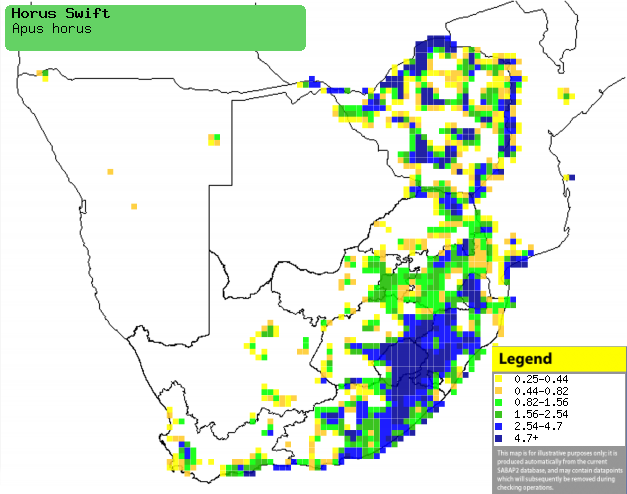|
Apus horus (Horus swift)
Horuswindswael [Afrikaans]; Sisampamema (generic term for
swallows, martins, swifts and spinetails) [Kwangali]; Lehaqasi (generic term for
swifts) [South Sotho]; Nkonjana (generic term for swift) [Tsonga]; Pêolwane,
Phêtla (generic terms for swifts, martins and swallows) [Tswana];
Horusgierzwaluw [Dutch]; Martinet horus [French]; Horussegler, Erdsegler
[German]; Andorinhão-das-barreiras [Portuguese]
Life
> Eukaryotes >
Opisthokonta
> Metazoa (animals) >
Bilateria >
Deuterostomia > Chordata >
Craniata > Vertebrata (vertebrates) > Gnathostomata (jawed
vertebrates) > Teleostomi (teleost fish) > Osteichthyes (bony fish) > Class:
Sarcopterygii (lobe-finned
fish) > Stegocephalia (terrestrial
vertebrates) > Tetrapoda
(four-legged vertebrates) > Reptiliomorpha > Amniota >
Reptilia (reptiles) >
Romeriida > Diapsida > Archosauromorpha > Archosauria >
Dinosauria
(dinosaurs) > Saurischia > Theropoda (bipedal predatory dinosaurs) >
Coelurosauria > Maniraptora > Aves (birds) > Order: Apodiformes >
Family: Apodidae
The bulk of the Horus swift's population is in southern
Africa, mainly in South Africa and Zimbabwe but strangely absent from Botswana.
It usually forages in flocks over open areas, feeding on a wide range of
insects. It is a monogamous, colonial nester, often living in mixed-species
colonies of about 2-10 breeding pairs. It usually takes control of old tunnels
excavated by other birds, building a small pad out of diverse materials glued
together with saliva, which it places in the chamber at the tunnel's end. Here
it lays 2-4 eggs, which are incubated for about 28 days. The chicks are born
with a grey-coloured down, and are cared for by both parents.
Distribution and habitat
Mainly occurs from Ethiopia south through Uganda, Kenya and
Tanzania to southern Africa. Within southern Africa it is locally common in the
Caprivi Strip (Namibia), Zimbabwe, eastern Botswana, western Mozambique and
South Africa, largely excluding the Northern Cape. It usually forages over open areas, such as
grassland, fynbos, desert, lakes, semi-desert, savanna and coastal dunes,
generally avoiding mountainous areas.
|
 |
|
Distribution of Horus swift in southern Africa,
based on statistical smoothing of the records from first SA Bird Atlas
Project (©
Animal Demography unit, University of
Cape Town; smoothing by Birgit Erni and Francesca Little). Colours range
from dark blue (most common) through to yellow (least common).
See here for the latest distribution
from the SABAP2. |
Predators and parasites
Food
It eats a wide range of insects caught aerially, often foraging in mixed species flocks. It may
descend to the ground, gleaning insects from the foliage of
trees or bushes. The following food items have been recorded in its diet:
Breeding
- Monogamous, colonial nester, often living in colonies
of about 2-10 breeding pairs, including other species such as
Brown-throated martins
and Common starlings.
- It usually takes control of old tunnels excavated by other birds, such
as bee-eaters, kingfishers (Coraciiformes),
swallows and martins,
Ant-eating chats
and Ground woodpeckers.
It then builds a small pad in the chamber at the end of the tunnel, made of
a variety of materials, including grass, leaves, plastic and feathers all
glued together with its saliva. The tunnel is usually placed in sand or
clay riverbanks, dongas, road cuttings, quarries or mine dumps.
- Egg-laying season is from August-April, peaking from September-January.
- It lays 2-4 eggs, which are incubated for about 28 days.
- The chicks are born with a grey-coloured down, and are cared for by both
parents.
Threats
Not threatened, in fact extremely common and widespread.
References
-
Hockey PAR, Dean WRJ and Ryan PG 2005. Roberts
- Birds of southern Africa, VIIth ed. The Trustees of the John Voelcker
Bird Book Fund, Cape Town.
|
